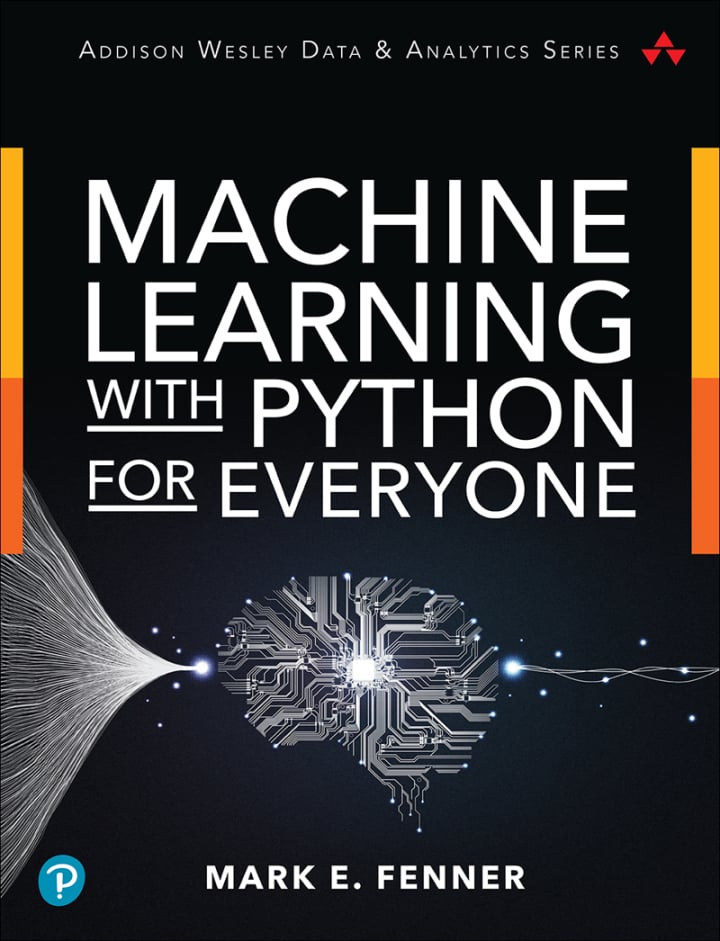
Machine Learning with Python for Everyone, 1st edition
PUBLISHER: PEARSON
eBook edition. 1 Year Subscription. Dành cho Cá nhân | Trường ĐH, Nhóm, Thư Viện: Gọi 0915920514 để báo giá Pearson, Vital Source eBook hoặc mua Sách In
Các sinh viên đang gấp rút nắm vững các kỹ thuật máy học mạnh mẽ để cải thiện khả năng ra quyết định và phân tích mở rộng quy mô thành các tập dữ liệu khổng lồ. Học máy với Python dành cho mọi người tập hợp tất cả những gì họ cần để thành công: hiểu biết thực tế về quy trình học máy, mã có thể truy cập, kỹ năng triển khai quy trình đó với Python và thư viện scikit-learn cũng như chuyên môn thực sự trong việc sử dụng hệ thống học tập một cách thông minh .Phản ánh 20 năm kinh nghiệm giảng dạy cho những người không chuyên, Tiến sĩ Mark Fenner giảng dạy thông qua các bộ dữ liệu được xây dựng cẩn thận, đủ phức tạp để gây thú vị nhưng cũng đủ đơn giản cho những người không chuyên. Dựa trên nền tảng này, Fenner trình bày các nghiên cứu điển hình trong thế giới thực áp dụng các bài học của mình theo những cách chi tiết và sắc thái. Trong suốt quá trình, anh ấy đưa ra những câu chuyện rõ ràng, “viết mã” thực tế và hình ảnh dễ hiểu -- chỉ tập trung vào toán học khi cần thiết để tạo kết nối và hiểu sâu hơn.
- Foreword xxiPreface xxiiiAbout the Author xxviiPart I: First Steps 1
- Chapter 1: Let’s Discuss Learning 31.1 Welcome 31.2 Scope, Terminology, Prediction, and Data 41.3 Putting the Machine in Machine Learning 71.4 Examples of Learning Systems 91.5 Evaluating Learning Systems 111.6 A Process for Building Learning Systems 131.7 Assumptions and Reality of Learning 151.8 End-of-Chapter Material 17
- Chapter 2: Some Technical Background 192.1 About Our Setup 192.2 The Need for Mathematical Language 192.3 Our Software for Tackling Machine Learning 202.4 Probability 212.5 Linear Combinations, Weighted Sums, and Dot Products 282.6 A Geometric View: Points in Space 342.7 Notation and the Plus-One Trick 432.8 Getting Groovy, Breaking the Straight-Jacket, and Nonlinearity 452.9 NumPy versus “All the Maths” 472.10 Floating-Point Issues 522.11 EOC 53
- Chapter 3: Predicting Categories: Getting Started with Classification 553.1 Classification Tasks 553.2 A Simple Classification Dataset 563.3 Training and Testing: Don’t Teach to the Test 593.4 Evaluation: Grading the Exam 623.5 Simple Classifier #1: Nearest Neighbors, Long Distance Relationships, and Assumptions 633.6 Simple Classifier #2: Naive Bayes, Probability, and Broken Promises 683.7 Simplistic Evaluation of Classifiers 703.8 EOC 81
- Chapter 4: Predicting Numerical Values: Getting Started with Regression 854.1 A Simple Regression Dataset 854.2 Nearest-Neighbors Regression and Summary Statistics 874.3 Linear Regression and Errors 914.4 Optimization: Picking the Best Answer 984.5 Simple Evaluation and Comparison of Regressors 1014.6 EOC 104Part II: Evaluation 107
- Chapter 5: Evaluating and Comparing Learners 1095.1 Evaluation and Why Less Is More 1095.2 Terminology for Learning Phases 1105.3 Major Tom, There’s Something Wrong: Overfitting and Underfitting 1165.4 From Errors to Costs 1255.5 (Re)Sampling: Making More from Less 1285.6 Break-It-Down: Deconstructing Error into Bias and Variance 1425.7 Graphical Evaluation and Comparison 1495.8 Comparing Learners with Cross-Validation 1545.9 EOC 155
- Chapter 6: Evaluating Classifiers 1596.1 Baseline Classifiers 1596.2 Beyond Accuracy: Metrics for Classification 1616.3 ROC Curves 1706.4 Another Take on Multiclass: One-versus-One 1816.5 Precision-Recall Curves 1856.6 Cumulative Response and Lift Curves 1876.7 More Sophisticated Evaluation of Classifiers: Take Two 1906.8 EOC 201
- Chapter 7: Evaluating Regressors 2057.1 Baseline Regressors 2057.2 Additional Measures for Regression 2077.3 Residual Plots 2147.4 A First Look at Standardization 2217.5 Evaluating Regressors in a More Sophisticated Way: Take Two 2257.6 EOC 232Part III: More Methods and Fundamentals 235
- Chapter 8: More Classification Methods 2378.1 Revisiting Classification 2378.2 Decision Trees 2398.3 Support Vector Classifiers 2498.4 Logistic Regression 2598.5 Discriminant Analysis 2698.6 Assumptions, Biases, and Classifiers 2858.7 Comparison of Classifiers: Take Three 2878.8 EOC 290
- Chapter 9: More Regression Methods 2959.1 Linear Regression in the Penalty Box: Regularization 2959.2 Support Vector Regression 3019.3 Piecewise Constant Regression 3089.4 Regression Trees 3139.5 Comparison of Regressors: Take Three 3149.6 EOC 318
- Chapter 10: Manual Feature Engineering: Manipulating Data for Fun and Profit 32110.1 Feature Engineering Terminology and Motivation 32110.2 Feature Selection and Data Reduction: Taking out the Trash 32410.3 Feature Scaling 32510.4 Discretization 32910.5 Categorical Coding 33210.6 Relationships and Interactions 34110.7 Target Manipulations 35010.8 EOC 356
- Chapter 11: Tuning Hyperparameters and Pipelines 35911.1 Models, Parameters, Hyperparameters 36011.2 Tuning Hyperparameters 36211.3 Down the Recursive Rabbit Hole: Nested Cross-Validation 37011.4 Pipelines 37711.5 Pipelines and Tuning Together 38011.6 EOC 382Part IV: Adding Complexity 385
- Chapter 12: Combining Learners 38712.1 Ensembles 38712.2 Voting Ensembles 38912.3 Bagging and Random Forests 39012.4 Boosting 39812.5 Comparing the Tree-Ensemble Methods 40112.6 EOC 405
- Chapter 13: Models That Engineer Features for Us 40913.1 Feature Selection 41113.2 Feature Construction with Kernels 42813.3 Principal Components Analysis: An Unsupervised Technique 44513.4 EOC 462
- Chapter 14: Feature Engineering for Domains: Domain-Specific Learning 46914.1 Working with Text 47014.2 Clustering 47914.3 Working with Images 48114.4 EOC 493
- Chapter 15: Connections, Extensions, and Further Directions 49715.1 Optimization 49715.2 Linear Regression from Raw Materials 50015.3 Building Logistic Regression from Raw Materials 50415.4 SVM from Raw Materials 51015.5 Neural Networks 51215.6 Probabilistic Graphical Models 51615.7 EOC 525Appendix A: mlwpy.py Listing 529Index 537















